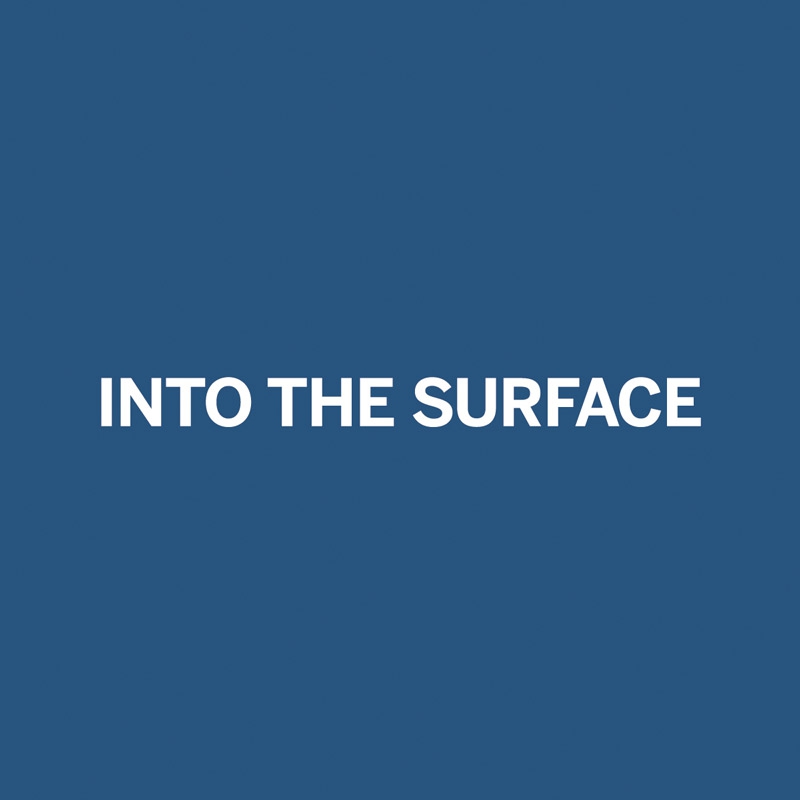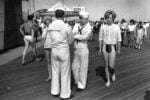Into the surface / Anthony James

Brand New Gallery è lieta di presentare la mostra collettiva Into the Surface e la mostra personale di Anthony James “Consciousness And Portraits Of Sacrifice”.
Comunicato stampa
Anthony James "Consciousness And Portraits Of Sacrifice"
Aaron Bobrow, Heather Cook, N. Dash, Alex Dordoy, Leo Gabin, Andrew Gbur, David Hominal, Erik Lindman, Nazafarin Lotfi, Joseph Montgomery, Oscar Murillo, Hugh Scott-Douglas, Dan Shaw-Town, Ben Schumacher, Nick Van Woert, Ned Vena, Phil Wagner, Lisa Williamson
Brand New Gallery is pleased to present the group exhibition Into the Surface.
This group of artists, being deeply concerned with transposing pictorial issues onto anti-conventional mediums in a traditional manner, focus their attention on the creative process for its own sake as compared to the representation of reality, pitting their various creative processes and attitudes against the concept of “abstract material”. By drawing on a collection of signs and strategies from the areas where these languages overlap in a continuous redefinition of the concept of form, the artists turn their attention to the primary principles of painting through the use of unusual, often simple, rough materials, denoting their place of origin and the experience the artists have shared with them.
These works, hybrids of painting and sculpture or painting and photography, are intensely and delicately conceived with a subtle sense of balance. It is interesting to note how each artist has a specific approach to the material that constitutes the artwork, from which poetic language is born. While Aaron Bobrow's canvases incorporate the accidental in aesthetics by exploring the life span of industrial materials (which are intent on becoming artwork through gestural signs), for the most part Phil Wagner works with poor materials, objects that have been found, recovered and recycled through a continuous expressive nexus between painting and sculpture; Alex Dordoy's works are initially also perceived through their physical medium and take the shape of industrial debris, in this case saturated in a mixture of pictorial substances. The pictorial approach is particularly present in the work of the collective Leo Gabin where the canvases conceal a social critique conceived through an aesthetic re-elaboration that aims to stimulate the imagination which has been kept in check by stereotypes offered by the proliferation of media images, but also the works of Oscar Murillo, which is concentrated on an archaeological process of collapse/ruin/restructuring whereby even the traces of dust on his studio floor are wilfully highlighted on his canvases. David Hominal, instead, returns to the ancient technique of encaustic painting to operate on a wide range of mediums through a process of construction and deconstruction of the image. Other artists choose to express themselves through artistic techniques that have almost procedural features, like Heather Cook, whose denim frottage in this exhibition investigates the confines between material and image by means of a phenomenological approach involving the subtraction of pigment thanks to the mechanical action of rubbing, or Ned Vena, where an aluminium panel incorporates layers of vinyl creating geometric, hypnotic plains furrowed by a pattern of ridges characterising the plastic material which has been applied. Andrew Gbur uses dribbles of serigraphic ink which seem to oppose the constriction of the adhesive tape which takes on the role of a stencil in his works, seemingly a visual distortion inherited from Op Art. Experimentation and process are behind the works of Hugh Scott-Douglas who retrieves an ancient cyanotype printing technique to elaborate once again minimalistic optical compositions. Nazafarin Lotfi's
Via Farini 32, 20159 Milano
www.brandnew-gallery.com [email protected]
works, on the other hand, border on monochrome and dark surfaces which devour light negating any form of visibility, here and there heterogeneous and misleading elements are made to emerge: a fishing line, staples, adhesive tape, rather than materials these are clues the artist sets before the viewer, necessary players in the theatrical representation of the void. Erik Lindman uses a satin canvas as the surface on which he intervenes with paint and pieces of fabric, reorganizing the surfaces and transforming material into image: a dark, rippled area gives way to an almost uncut section, like a poster which has been ripped to reveal what is underneath. Dan Shaw-Town makes use of the traditional visual language of design, his works hark back to an elementary model generated by lines and graphite signs, however, these designs don a variety of surfaces and textures achieved through meticulous processes of sanding, cancelling and painting: the surfaces thus eroded, lay bare rather than remove the signs of the work's creative process. The salient features of N. Dash's work are an underlying purity and a private, introspective language where the artist-demiurge's touch remains in the folds and creases of the fabric, changing the material irreversibly; the result is an almost random process, sealed with indigo pigment, a colour originating from India and endowed with ancient anthropological value. More than anything else, Ben Schumacher is interested in the concession of the object in image and he analyses this theme in depth through sculptural installations which he documents through images, creating a visual pretence of the original object. Alongside Schumacher, other artists underline the sculptural aspect which seemingly cannot be left aside when dealing with material: Joseph Montgomery's works extend beyond the limits of the canvas, they become pictorial objects through collages of plastic elements in wax, fibreglass and cardboard, while Lisa Williamson investigates the expressive potential of objects through repositioning them, in a rigorously formal work where materials take on intuitive and cognitive functions. Finally, Nick Van Woert does not hide his interest in architecture, a discipline which has a strong influence on his work: indeed, the artist believes in the semantics of material and focuses his interests in common materials and building materials; at the same time, his works are a criticism and service to the built environment and the human tendency towards territorial expansion.
Into the Surface
12 January – 23 February 2012
Brand New Gallery
via Farini 32, 20159 Milano
t. +39.02.89.05.30.83
da martedì a sabato
11.00-13.00|14.30-19.00
[email protected]
www.brandnew-gallery.com
Catalogue
published by Brand New Gallery
Essay by Eric Shiner
Ufficio stampa
Lucia Crespi
via Francesco Brioschi 21, 20136 Milano
t. +39.02 89415532 - 02 89401645
[email protected]
Via Farini 32, 20159 Milano
www.brandnew-gallery.com [email protected]
BRAND NEW GALLERY
presenta
Into the Surface
12 gennaio - 23 febbraio 2012
Opening: 12 gennaio | 19.00-21.00
Aaron Bobrow, Heather Cook, N. Dash, Alex Dordoy, Leo Gabin, Andrew Gbur, David Hominal, Erik Lindman, Nazafarin Lotfi, Joseph Montgomery, Oscar Murillo, Hugh Scott-Douglas, Dan Shaw-Town, Ben Schumacher, Nick Van Woert, Ned Vena, Phil Wagner, Lisa Williamson
Brand New Gallery è lieta di presentare la mostra collettiva Into the Surface.
Fortemente interessati a trasporre in maniera tradizionale interessi pittorici su supporti e media anticonvenzionali, questo gruppo di artisti focalizza l’attenzione sul processo creativo in sé rispetto alla rappresentazione della realtà, relazionando i propri diversi processi creativi ed il proprio atteggiamento al concetto di "materia astratta". Adottando un insieme di segni e strategie laddove linguaggi diversi si intrecciano in una continua ridefinizione del concetto di forma, questi artisti indirizzano i loro interessi al principio elementare della pittura attraverso l'uso di materiali inusuali, spesso semplici e grezzi, segnati dal luogo d’origine e dalle esperienze con essi condivise.
Ibridi tra pittura e scultura o tra pittura e fotografia, queste opere sono concepite con intensità, delicatezza ed un sottile senso di equilibrio. È interessante notare come ogni artista abbia un approccio specifico e differente alla materia che costituisce l’opera d’arte, da cui scaturisce una diversa poetica di fondo. Se le tele di Aaron Bobrow incorporano l’accidentale nell’estetica attraverso l’esplorazione dei limiti di vita dei materiali industriali (protési attraverso segni gestuali a divenire oggetti d’arte), Phil Wagner lavora principalmente con materiali poveri, oggetti ritrovati, recuperati e riciclati attraverso un continuo collegamento espressivo tra pittura e scultura; anche le opere di Alex Dordoy vengono percepite in primo luogo attraverso il supporto fisico e si configurano come detriti industriali, questa volta impregnati di un miscuglio di sostanze pittoriche. L’approccio pittorico è particolarmente presente nel lavoro del collettivo Leo Gabin, le cui tele celano una critica sociale concepita attraverso una rielaborazione estetica che cerca di stimolare l’immaginazione, imbrigliata negli stereotipi offerti dalla proliferazione delle immagini che scaturiscono dai media, ma anche nel lavoro di Oscar Murillo che si concentra su di un processo archeologico di crollo/rovina/ristrutturazione per cui anche i segni lasciati dalla polvere del pavimento del suo studio sono volutamente evidenziati sulla tela. David Hominal, invece, recupera una tecnica antica come quella dell’encausto per operare su una vasta gamma di supporti attraverso un processo di costruzione e decostruzione dell’immagine. Altri artisti scelgono di esprimersi attraverso tecniche artistiche dalle caratteristiche quasi processuali, come Heather Cook, il cui denim frottage in mostra indaga il confine tra materia e immagine attraverso un approccio fenomenologico che comporta la sottrazione del pigmento grazie ad un’azione meccanica di sfregamento, o come Ned Vena, il cui il pannello d’alluminio incorpora strati di vinile restituendo piani geometrici ed ipnotici ed è solcato da un pattern costituito dalle piccole creste caratterizzanti il materiale plastico applicato. Le sbavature degli inchiostri serigrafici utilizzati da Andrew Gbur sembrano opporsi alla costrizione del nastro adesivo che nelle sue opere funge da stencil, alla ricerca di una distorsione visiva che sembra lasciata in eredità dalla Op Art. Sperimentazione e processualità sono alla base del lavoro di Hugh Scott-Douglas che recupera un antico metodo di stampa come il cianotipo, attraverso cui
Via Farini 32, 20159 Milano
www.brandnew-gallery.com [email protected]
elabora composizioni ancora una volta ottiche e minimaliste, mentre le opere di Nazafarin Lotfi rasentano la monocromia e la superficie scura inghiotte la luce rinnegando ogni forma di visibilità, facendo comparire qua e là elementi eterogenei e fuorvianti: un filo da pesca, delle graffette, un nastro adesivo, più che materiali in sé sono indizi di fronte a cui l’artista pone lo spettatore, come attori necessari per una rappresentazione teatrale del nulla. Erik Lindman utilizza come supporto una tela di raso, su cui interviene con pittura ed inserti in stoffa, riorganizzando le superfici e trasformando la materia in immagine: una distesa scura ed increspata lascia posto ad una sezione quasi intonsa, come un poster strappato per rivelare ciò che stava sotto, mentre Dan Shaw-Town si avvale di un linguaggio visivo tradizionale, quello del disegno, le sue opere si rifanno ad un modello elementare generato da righe e da segni di grafite, ma questi disegni si vestono di una varietà di superfici e trame ottenute attraverso un meticoloso lavoro di levigatura, cancellatura e pittura: le superfici, così consumate, anziché privare mettono a nudo i segni visibili del processo di creazione dell’opera. Il lavoro di N. Dash è caratterizzato da una purezza di fondo e da un linguaggio privato e introspettivo, in cui il tocco dell’artista-demiurgo permane nelle pieghe e nelle grinze del tessuto alterando la materia in modo irreversibile; ne risulta un processo quasi aleatorio, sigillato per mezzo del pigmento indaco, tinta originaria dell’India e contraddistinta da un valore antropologico antichissimo. Ben Schumacher è più che altro interessato al cedimento dell’oggetto in immagine e approfondisce questo tema creando installazioni scultoree che documenta sottoforma di immagini, creando una finzione visiva dell’oggetto originale. Insieme a lui, altri artisti evidenziano un approccio scultoreo che sembra essere imprescindibile quando si tratta di materia: le opere di Joseph Montgomery si estendono oltre le restrizioni della tela, diventando oggetti pittorici attraverso il collage di elementi plastici in cera, fibra di vetro e cartone, mentre Lisa Williamson indaga il potenziale espressivo degli oggetti attraverso il loro riposizionamento, in un lavoro rigorosamente formale in cui i materiali assumono funzioni intuitive e cognitive. Infine, Nick Van Woert non nasconde il suo interesse per l’architettura, una disciplina che influenza fortemente il suo lavoro: l’artista, infatti, crede nella semantica della materia e focalizza il proprio interesse su materiali comuni e da costruzione; le sue opere sono, allo stesso tempo, critica e resa per l’ambiente costruito e per la tendenza umana all’espansione territoriale.



